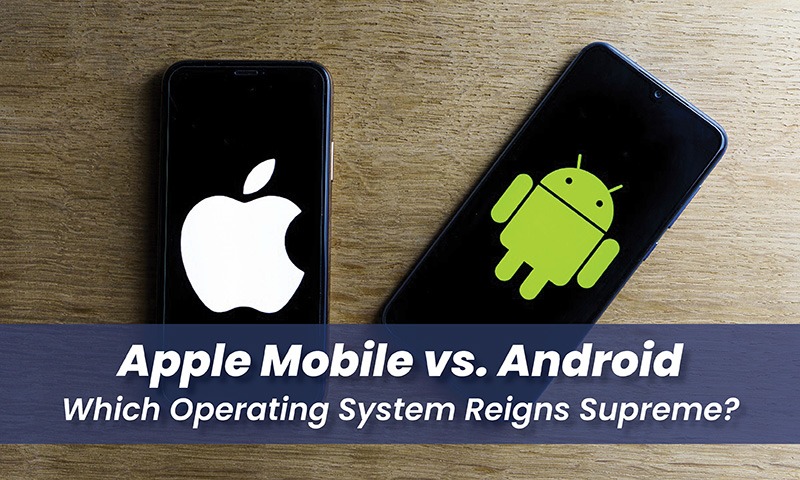In the world of smartphones, two giants have been battling it out for dominance: Apple’s iOS and Google’s Android. These two operating systems power the majority of mobile devices on the market today. As a consumer, choosing between them can be a tough decision. Both have their strengths and weaknesses, but ultimately, one must reign supreme. In this article, we will compare Apple Mobile and Android, exploring their features, user experience, app ecosystem, and more, to help you make an informed choice.
User Interface and Design
When it comes to user interface (UI) and design, Apple Mobile and Android have distinct approaches. Apple’s iOS is known for its sleek, minimalist design, featuring clean lines, consistent icons, and a visually appealing interface. The company takes great pride in its attention to detail, resulting in a seamless user experience that feels intuitive and user-friendly.
On the other hand, Android offers a more customizable experience. With Android, users have the freedom to personalize their device’s appearance, including home screen layouts, widgets, and themes. Android’s UI may vary slightly across different manufacturers, as they often implement their own custom skins on top of the core Android OS.
App Ecosystem
One crucial aspect to consider when choosing a mobile operating system is the app ecosystem it offers. In this regard, Apple Mobile has the upper hand. The Apple App Store boasts a vast selection of high-quality applications, ranging from productivity tools to entertainment apps and games. Apple’s strict app review process ensures that only reliable and well-designed apps make it onto their platform, giving users a sense of security.
Android, on the other hand, benefits from its open nature. The Google Play Store offers a wide array of applications, including many that are not available on the Apple App Store. While this provides users with more options, it also means that the quality of apps can vary. Android’s open ecosystem allows developers to experiment more freely, but it can also lead to a higher presence of low-quality or potentially harmful apps.
Device Variety
Apple Mobile is known for its limited device variety, offering a small range of iPhones and iPads. However, this can be seen as an advantage in terms of software optimization. Apple can tailor its operating system to work seamlessly with its own hardware, resulting in a smooth and optimized user experience.
On the other hand, Android powers a vast range of devices from various manufacturers. This diversity allows users to choose a device that suits their specific needs and budget. However, it also means that software updates may take longer to reach all Android devices, as manufacturers and carriers need to adapt and distribute them.
Integration with Ecosystem
Both Apple Mobile and Android offer integration with their respective ecosystems, which can heavily influence the user experience. Apple’s ecosystem includes seamless integration with other Apple devices, such as Macs, iPads, and Apple Watches. This integration allows for effortless synchronization of data, easy file sharing, and the ability to answer phone calls or respond to messages from any Apple device.
Android integrates with Google’s suite of services, including Google Drive, Gmail, and Google Photos. This integration provides a cohesive experience for users who heavily rely on Google’s services. Additionally, Android devices often come with built-in support for popular Google apps and services.
Privacy and Security
Privacy and security are paramount when it comes to mobile devices. Apple has consistently emphasized its commitment to user privacy. The company’s strict privacy policies, strong encryption, and features like Face ID and Touch ID contribute to a secure environment for iOS users.
Similarly, Android has made significant strides in improving privacy and security over the years. Android devices offer features such as app permissions and biometric authentication. However, the fragmented nature of the Android ecosystem means that software updates and security patches may not reach all devices in a timely manner, potentially leaving some users vulnerable to security threats.
Conclusion
In the battle between Apple Mobile and Android, both operating systems have their strengths and weaknesses. Apple Mobile offers a seamless user experience, a curated app ecosystem, and tight integration with other Apple devices. On the other hand, Android provides more customization options, a wider range of device choices, and integration with Google’s suite of services.
Ultimately, the choice between Apple Mobile and Android depends on your personal preferences and needs. If you value simplicity, a secure ecosystem, and a consistent user experience, Apple Mobile may be the right choice for you. On the contrary, if customization, device variety, and integration with Google’s services are important to you, Android might be the better option. Consider your priorities, explore the features of each operating system, and make an informed decision that aligns with your preferences and lifestyle.












